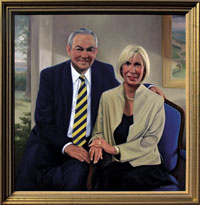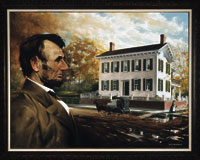Many artists capture the image of their subject, but William F. Hardin really tries to incorporate a subject’s life accomplishments into his paintings.
Hardin was practically born with a paintbrush in his hand—his parents both shared a love of painting and met at the Art Institute of Chicago. He is a graduate of Bradley University, and owner of Hardin Signs, which he started in 1967 with his wife, Marian. After watching both his three children and the success of his business grow, Hardin decided to seriously pursue his passion of painting portraits.
Over 25 years ago, Hardin was commissioned to paint his first portrait of a local businessman. When the quality wasn’t as perfect as Hardin would have liked it to be, he used the money he earned from the commission to attend art school in New York under John Howard Sanden, where he learned how to apply color and how to use a mirror to look at the painting in reverse in order to correct proportion and value.
Hardin first begins a work by making a representation that is about a quarter of the actual size.
“If I decide I need to add or subtract something in the study, I can do it more easily because I can change it much quicker on the smaller scale,” Hardin said. “I don’t do much detail on the smaller scale, just the basics; it lets me develop my composition and color values.”
Hardin likes to add as much detail to a portrait as he can. If possible, he prefers to take photos of his subjects. One problem that Hardin often runs into is that many times the subject is deceased and he does not have photos of the person during the period of his or her life that is requested. This is when Hardin’s skills really come out in a portrait. He will often just have a photo of a face and must recreate the body using live models to display the bodies and hands. Hands are a very important part of Hardin’s portraits, as he feels that they can really display the character of a person.

Hardin's portraits of former Caterpillar Chairman and CEO Glen Barton and wife, Polly, (above) and President Abraham Lincoln at his Springfield home (below).

Hardin may also incorporate part of a subject’s life in the background of a picture. In one portrait he included a photo of the subject’s wife on a bookshelf next to him, because Hardin realized the importance of the wife in the subject’s life through speaking with her. In his paintings of Congressman Bob Michel, Hardin included the view of the Washington Monument from Michel’s old Washington, D.C. office.
More than 20 of Hardin’s portraits are on display at Bradley University, but not by chance. He first had to prove his skills to former Bradley President Martin Abegg by painting a portrait of the university’s founder—Lydia Moss Bradley. He then went on to paint portraits of Abegg, along with former president John Brazil, Mabel Dingledine, Tom and Ellen Foster, Jack and Mary Hartmann, Valentine Jobst III and A.J. Robertson, just to name a few.
While Bradley University is the leading requester of commissions from Hardin, the artist has also painted many other prominent figures. Two of Hardin’s portraits of Congressman Michel hang in the U.S. Capitol Building and the Capitol Hill Club. A portrait of Mayo Clinic founders Will and Charlie Mayo hangs in the Mayo Clinic in Rochester, Minnesota. Other area figures in Hardin’s portfolio include former Caterpillar CEO Donald Fites; Caterpillar Vice President Sid Banwart and his wife Flo; Jane Converse, the founder and president of Converse Marketing Inc.; Congressman Ray LaHood; and Lucie Brotherson Tyng, the founder of Tyng Primary School.
One of Hardin’s recent ventures is a second production of small loose-leaf desk calendars, which can be easily displayed in a compact disc case. His first such calendar was published last year. The cover of the 2007 calendar features Hardin’s portrait of State Representative David Leitch. Other paintings in the 2007 calendar include Abraham Lincoln next to his home in Springfield, Peoria native and Chicago White Sox slugger Jim Thome and Betty Friedan, the Peoria native and author of the bestseller The Feminine Mystique, who passed away last year. In addition to featuring Hardin’s portraits, the calendars detail the accomplishments of each person featured and how they have made an impact on central Illinois.
Approximately 20 years ago, Hardin bought a home in Jacksonport, Wisconsin, where he set up a studio and now spends most of his time painting. When he’s not painting portraits—a very rare occurrence, as his services always seem to be in demand—Hardin enjoys painting landscapes, seascapes, flowers, animals and other nature scenes.
Because Hardin isn’t represented by a gallery, commissions can be arranged directly through him. Hardin also volunteers to donate the proceeds made from a portrait to any legal charity that the subject chooses. He feels that this is his way of giving back to the community for “all of the gifts” it has given to him.
Hardin attaches great sentimental value to his art. He has painted portraits of both of his parents and continues to use his father’s oil painting box with the year 1908 carved into it. He enjoys his paintings much more knowing that they have gone to a good cause, as many of his portraits hang in remembrance of people in the places where they have made a difference.
Some of Hardin’s favorite moments are when the subject and his or her family sees the painting for the first time. For this reason, Hardin is often involved in the unveiling of his works.
“Everyone has a special quality that comes forth in the finished portrait,” Hardin said. “The moment the subject sees the finished product for the first time is worth all the hours spent in anticipation of this moment.” a&s


